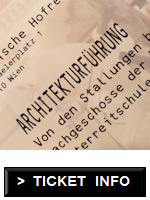The main guided tour of the Spanish Riding School takes in the double joy of the Baroque winter arena and the Renaissance stables. The less frequent architectural tour does the same, but with a notable bonus.
- Go up into the arena roof
- Enjoy rare views of central Vienna
- Also see the horses at home
- Lovely guide full of insight
- Book tour tickets* for the riding school
- See also:
Into the roof

(The roof trip may be a highlight but you still get to see the horses up close; photo taken with kind permission of the SRS during a previous press tour)
Vienna has plenty of places that let you touch the past. (Though keep your hands off the keys on Haydn’s clavichord.)
The Spanish Riding School is one of them, with a popular standard guided tour that takes you around the early 18th-century winter arena and the Renaissance Stallburg stables. Look into the gleaming eye of a Lipizzaner stallion to see the reflections of generations of horses who shared the same stables
The arena part of that standard tour places you where the public sit for a performance or training. But a rarer architectural tour goes one better, allowing you to climb up through various levels to see the locations normally only viewed by maintenance staff and the ghosts of Baroque carpenters.
My architectural tour began in the VIP seating area of the empty arena beneath the portrait of Emperor Charles VI (who built it all). We then moved up to the lower and upper general seating levels.
At each stop, the guide (who was excellent) took us further into the history & organisation of the school and its horses. Then the focus turned to the building itself as we neared the ceiling.
Remarkably, the arena remains more or less as it was when completed in 1735. The guide’s anecdotes and insights added a colour to the surrounds you don’t get as a casual visitor.
For example, given the construction date and its court affiliation, you’d expect everything to be a kaleidoscope of frescoes and a frenzy of gold decoration.
Yet the arena is (relatively) unostentatious. All because they wanted you to focus on the horses. And the light colours helped with luminosity in the days when electricity remained a secret known only to lightning-wielding gods.

(Get a closer look at the dome that tops one entrance to the Hofburg complex)
Then we went genuinely behind the scenes. Or, rather, above the scenes: up the staircase, through a ceiling that turns out to be just stucco and wood to where the secrets of the past revealed themselves.
No stone balustrades and Imperial emblems here. Instead…wooden floorboards and a vista reminiscent of an abandoned Victorian warehouse.
Then up another floor, with its 18th-century timbered columns and remains of the original winches. And then a final ascent to just below the roof and the highlight of the architectural tour: two small windows with secret views of the outside.
One window looked across Michaelerplatz to mighty Stephansdom cathedral.
The other, less familiar, view was down into an inner courtyard and toward the Michaelerkuppel: the glorious green and gold dome that tops one entrance to the Hofburg palace complex.
The guide gave us plenty of time to wander across the top level and take in reminders of the recent and far past: from 16th-century timber to beams charred in the Hofburg fire of 1992.
Vienna below churns with phone-waving visitors. But up in the roof you experience a stillness and a curious sense of reverence.
Find some stoic timber tucked away in a corner, and the last person to brush past might have been a labourer from a Silesian Duchy nervous about Prussian expansionism. (Rightly so: the First Silesian War broke out in 1740.)
After a quick peek at the courtyard training facility, the tour then continued over the road in the stables, which is otherwise off limits for the public.
There we had a shorter version of what I experienced on the standard tour. But still with enough time to admire the horses at home, learn about their life and management, and whisper words of admiration at an imperious stallion who had clearly heard it all before.
Tickets & tips
The English-language architectural tour takes place about once a week at the time of writing, with tickets available from the school itself and various sources.
(Booking service provided by Tiqets.com*, who I am an affiliate of)
The tour costs a little more than the standard version and takes around 20 minutes longer. So which one should you do?
First of all, it may be a simple matter of availability.
The normal tour takes place most days so fits more easily into your travel schedule. If your main priority is seeing the horses and the stables, then you have another reason to stick with this basic option.
If however, you want to see the horses and stables but also enjoy a rare and exclusive dive (or rather climb) into architectural history, then the architecture tour is very much worth the extra couple of Euros.
Whichever tour you might do, I strongly recommend seeing a public training (or performance), too. This lets you see theory turned into practice, and you come away with a rounded understanding of the organisation, the horses, and their abilities.
How to get to the tour
The meeting point is at the far wall of the main visitor and ticket hall (see the main article for travel tips), right next to a display case of memorabilia with commemorative gifts from the likes of the Ancient and Honorable Artillery Company of Massachusetts(!).
Address: Michaelerplatz 1, 1010 Vienna
